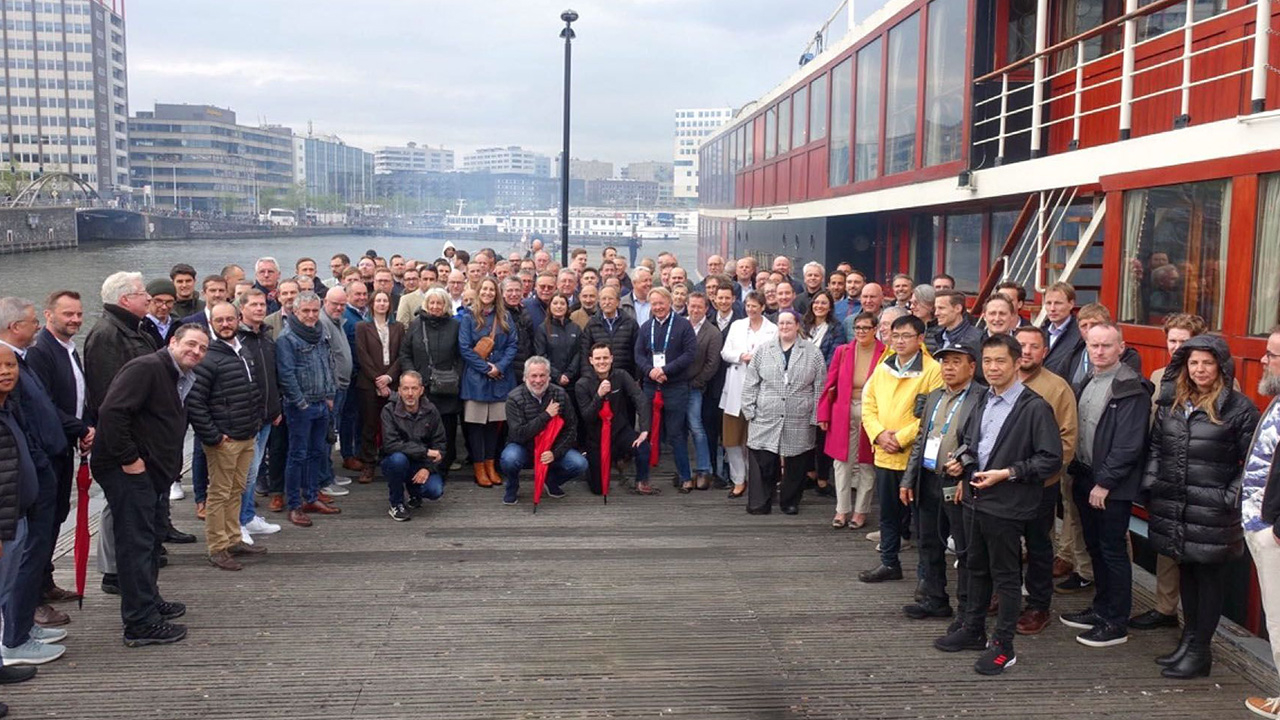Drupa technology trends

Some of the UK’s leading label converters attended a BPIF seminar looking in more detail at some key technology trends unveiled at drupa. Andy Thomas reports
The British Print Industries Federation’s labels section ran a very successful technical seminar in May focusing on post-Drupa technology trends.
Opening the proceedings, Neil Falconer of the Print Future consultancy issued a stark warning to UK label converters: ‘There is too much capacity and the wrong type of skills and equipment.’
New skill sets are required for future success, said Falconer, and converters will need to invest in technologies like digital asset management and workflow as well as the training to make them work. ‘Today, business is not about putting ink on paper but how to use the available tools to give a point
of differentiation.’
Label converters need to live in a different world, where they are a part of a brand’s marketing conversation. ‘Brands are integrating their budgets, so point of sale collateral is as important as the primary and secondary packaging.’ The business opportunity is to offer a range of new services from asset management to flexible packaging, building on the core labels business.
Converters must also see themselves as part of the supply chain. ‘To help brands re-engineer supply chains is key. Delivering print close to the point of packing and filling and printing on demand.’ Falconer pointed out that in the pharma industry delivery times have reduced from 17 weeks to just two days, which had resulted in 70 percent savings on packaging material costs and cut overall supply chain costs by 30 percent, with waste reduced from 20 percent to almost zero. ‘This is a new world away from price per label. This is not the end of conventional packaging, but we are at a tipping point and the pressures will increase.’
Already there is an unstoppable trend to shorter runs, with 65 percent of jobs less than 50,000 linear meters. But Falconer warned against seeing digital printing as a magic bullet. ‘You have a new service offering, meaning new business, but digital print is already a commodity market. So you still need some point of differentiation.’
Profitable production of shorter runs brings the associated need to finish, dispatch and invoice, and converters need to embrace automated workflows whether they print conventionally or digitally, said Falconer.
Digital opportunities
Drupa showed digital print suppliers opening up new opportunities for added value production. Paul Briggs at Xeikon UK forsees a growing demand for short runs of digitally printed folding cartons after the company introduced its B2 format carton press with inline die cutting/creasing or sheeting at Drupa. The press is able to handle substrates up to 600 microns as well as the full range of current label substrates.
Digital cartons are also a key application for Screen’s JetSX B2 sheetfed press launched at Drupa. The company’s Carlo Sammarco said the press has a flat sheet transport system designed with these thicker substrates in mind. Sammarco also used the seminar to give more details of Screen’s first dedicated digital label press, the prototype TruePress L350UV seen at Drupa, The UV inkjet press uses 600dpi native print heads with four gray levels, printing at speeds up to 50 m/min on web widths between 100mm to 350mm. Sammarco said a white ink will be demonstrated at Labelexpo Americas and an extended gamut ink set will be available by Q1 2013.
Domino’s Steven Hancock talked about how the company is integrating digital spot varnishing and digital cold foiling into its N600i inkjet press using the ABG Digicon digital converting platform.
Hancock said there is still a place for monochrome inkjet heads on conventional presses where only the black information changes and run lengths are too long for a digital press. Applications include track and trace, batch numbering on pharma labels, variable numbering systems linked with an online database, and numbered retail coupons. Other variable print opportunities include promotional games and multi-part labels enticing consumers to enter details through their smart phones. Hancock cited a promotion by cordials manufacturer Robinsons where QR codes take consumers to a competitions website where they enter a unique number found on the label. ‘This all represents major opportunities for new business.’
Hancock said DoD (drop-on-demand) inkjet heads can now be scaled to match any web width, allowing variable black printing at full web width. This technology also underpins Domino’s digital varnishing and foiling technology where the need is for high coverage across the web width. The heads can be mounted either inline on a press or on finishing equipment, or on a dedicated module which can be moved between different presses and rewinders.
In a Q&A session, delegates asked about price trends for inkjet inks, and were told the price has fallen from 300 GBP per kg to 100 GBP per kg over the past four years, and it is expected to fall ‘very significantly’ in the coming years.
Digital platemaking
With so much attention focused on digital printing, it is easy to forget the strides still being made in digital platemaking.
Paul Briggs said Xeikon has made a major commitment to the flexo CTP market with the acquisition of FlexoLaser’s technology. This forms the basis of the ThermoflexX launched at Drupa for the imaging of ablation flexo and letterpress plates. Xeikon’s strategy is to offer digital options for conventional presses as well as complete digital print and converting lines.
Screen has also launched a flexo CTP system on the back of its successful litho technology. The PlateRite FX1524 will handle all LAMS flexo, letterpress, screen and thermal offset plates at resolutions up to 4800dpi for high definition flexo printing.
At Drupa, Esko introduced the Spark CDI 4835 Auto which combines automatic plate loading, LED back exposure and ablation in one operation. ‘This gives total consistency and no hot spots and we can hold 6-10 micron dots,’ said EskoArtwork’s Paul Bates.
A discussion illuminated the issues surrounding flat top verses round top flexo dots. To summarize: round dots give you ‘fantastic’ one percent highlights, but cannot match other processes when printing solids, particularly on filmic materials. Flat top dots, on the other hand, deliver pinhole-free solid areas matching gravure, but are more difficult to control on the highlights.
‘With our inline UV2 plate processor technology we control the UV output to allow both round and flat dots to be combined on the same plate,’ said Bates. ‘The vignettes are of offset and gravure quality.’ Bates said Esko has made 450 HD Flexo installations in the last two years and carried out 175 certifications. ‘We are working with both end users and press manufacturers to drive the technology.’
New opportunities
ABG’s Matthew Burton outlined four possible new revenue streams for PS label converters: short run cartons, short run flexible packaging, in-mold labels and web-to-print with inline laser die-cutting. Burton told delegates that at Drupa ABG had seen a significant interest in HP Indigo’s upcoming wider format (762mm) 20000 press targeted at short run flexible packaging applications. The company is investigating semi-rotary converting of mid-web digital printed webs up to one meter and already offers a low cost offline laminator.
For IML, ABG works with finishing partners specialized in handling these difficult substrates off the roll.
A key focus for ABG is laser die-cutting. Burton gave the example of two US converters, Sticker Giant and Digital Dogma, doing web to print label work using laser die-cutting to move jobs quickly through the business. Sticker Giant estimates it has saved 100k US dollars on die tooling in 12 months and is now looking at a second ABG laser die-cutter. At Digital Dogma the company says it is saving up to 5000 GBP per month on die costs.
ABG is now working on automating delivery of its laser die-cut files with MIS suppliers Labeltraxx and Cerm. Burton likened the current state of laser die- cutting to the emergence of digital print in the 1990s.
EskoArtwork, meanwhile, consolidated its position at the heart of labels and packaging digital workflows with the announcement at Drupa that its holding company had acquired X-rite/Pantone.
‘This brings the Pantone library within the Esko group and allows us to open Cloud-based color management to everyone,’ said Bates. ‘The Pantone Live database gives everyone information about color at the earliest stage of design. Colors like Cadbury blue will be profiled just once and then can be shared by anyone with a license.’
Bates also described how Esko’s Suite 12 now allows converters to offer their clients remote approval of labels and packaging rendered in 3D on an ipad. ‘We can automate the process by linking a printer’s MIS, like a LabelTraxx, directly to our on-line approval system.’
In other presentations, David Galton looked at Asahi’s latest flexo plate technologies, while Wayne Dobson of Virgo Environmental discussed the possibility of setting up a recycling plant in South Wales utilizing a new enzyme technology. This recycling method is being tested in a pulp recovery mill in Thailand, with a JV in Malayasia launched last year. The proposed South Wales plant could use paper liner waste as a feedstock.
The seminar also heard a presentation from the European Flexographic Industries Association (EFIA), which introduced its modular Academy Two e-learning program.
The day ended with a presentation from Herma’s Colin Phillips on behalf of Finat and a dinner. The next seminar is scheduled for 31 October, again at the Barceló (now PUMA) hotel in Daventry.
Conventional vs digital
Digital printing is taking more and more short run territory from conventional press technology. But Gidue managing director Federico d’Annunzio said flexo press manufacturers are ‘not afraid’ of digital printing, claiming that by digitizing control of UV flexo’s twin variables – print register and pressure – a modern flexo press can be competitive down to run lengths of just 5,000 linear meters when all cost factors are taken into account.
This type of ‘Digital Flexo’ system is ‘self-learning’, said d’Annunzio, automatically adapting itself as the variables change. This level of control is made easier with flat top dots, which exhibit less dot gain and are easier to control.
D’Annunzio said digital print technologies have their own limitations. While the higher quality toner-based systems have probably reached a physical limit in terms of speed and width, inkjet has relatively low (native) resolutions and is more expensive to scale across wider press widths, he said.
‘On a Digital Flexo press we can achieve 20 meters of waste no matter how long the press, since there is only one "digital" operator’.
BPIF state of play
BPIF Labels has been rejuvenated under the leadership of non-executive chairman John Bambery, who aims to make the organization the main voice in the UK for the PS label converting industry.
‘With a one third increase in membership and, our technical seminars now gaining credibility, companies are now beginning to realize that a collective voice in helping to solve some of the industry’s problems is the way forward’, Bambery told L&L. ‘The post-drupa technical seminar enabled companies to be made aware of the developments in the wider world of printing and how they are impacting on the self adhesive and narrow web sectors.’
BPIF Labels has already published two brochures: Recycling of Backing Waste and Ink Migration. The next publication will be a code of practice for the production of labels for the food and ‘sensitive’ product sectors.
Pictured: Delegates at the BPIF’s post-Drupa technology round up
This article was published in L&L issue 4, 2012
Stay up to date
Subscribe to the free Label News newsletter and receive the latest content every week. We'll never share your email address.


